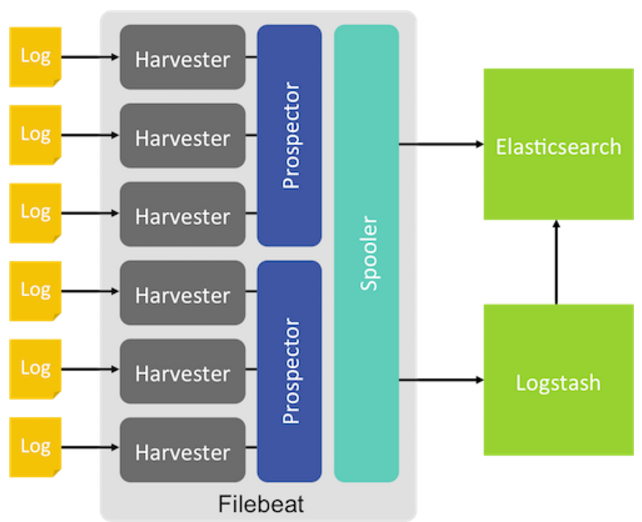ELK日誌檢索系統--FileBeat配置說明
0. FileBeat使用說明
FileBeat是一個日誌收集器,基於Logstash-Forwarder的原始碼。FileBeat一般以代理的身份執行在伺服器中,並監視使用者指定的目錄、檔案,同時把日誌檔案更新部分推送給Logstash解析或者直接推送給ES索引。
FileBeat的工作方式:
當FileBeat在伺服器上啟動後,它同時啟動一個或者多個prospectors來監視使用者指定的日誌檔案目錄。
prospectors然後針對每個日誌檔案,都啟動一個harvester,每一個harvester監視一個檔案的新增內容,並把新增內容送到spooler中。然後spooler來彙總這些events
1. FileBeat的安裝
FileBeat的使用與ES、Logstash基本一樣,從官方網站下載*.tar.gz檔案,然後解壓。新增配置檔案,然後就可以運行了。
deb:
curl -L -O https://download.elastic.co/beats/filebeat/filebeat_1.3.1_amd64.deb
sudo dpkg -i filebeat_1.3.1_amd64.debrpm:
curl -L -O https://download.elastic.co/beats/filebeat/filebeat-1.3.1-x86_64.rpm 如果用rpm或者deb的安裝包,配置檔案的位置在:
/etc/filebeat/filebeat.yml,下面是一個預設的配置檔案:
filebeat:
# List of prospectors to fetch data.
prospectors:
# Each - is a prospector. Below are the prospector specific configurations
-
# Paths that should be crawled and fetched. Glob based paths.
# For 2. FileBeat檔案路徑配置、ES輸出
設定日誌檔案的路徑,每一個prospector監視一個路徑(目錄)。
/var/log/*/*.log這個路徑代表log的所有子目錄中的字尾為log的日誌檔案。但是不會監視log目錄中的日誌檔案。
設定FileBeat的輸出物件
如果output為ES,那麼配置檔案:
# Configure what outputs to use when sending the data collected by the beat.
# Multiple outputs may be used.
output:
### Elasticsearch as output
elasticsearch:
# Array of hosts to connect to.
hosts: ["192.168.1.42:9200"]3. 設定Logstash為output物件
可以設定FileBeat的輸出物件為Logstash,把FileBeat收集的資料推送到Logstash進行解析。
註釋掉第二步驟中的ES的輸出配置,新增下面的內容:
output:
logstash:
hosts: ["127.0.0.1:5044"]其中hosts指定了Logstash的IP地址和Logstash在其自己的配置檔案中指定的監聽埠。
如果把Logstash設定為輸出物件,必須手動載入ES的索引模板。
通過./filebeat -configtest -e測試配置的FileBeat指令碼
4. 在FileBeat中為ES設定索引模板
有了FileBeat以後,收集器是FileBeat,也只有FileBeat自己清楚其所監視的日誌是什麼格式。所以它可以為ES的索引定製模板。
推薦模板在FileBeat安裝包裡有預設的配置。
如果FileBeat的output是ES,那麼可以在FileBeat的配置檔案中設定ES索引模板。
如果FileBeat的output是logstash,那麼必須手動載入ES索引模板。
FileBeat通過配置檔案自動為ES載入索引模板(輸出物件必須為ES):
output:
elasticsearch:
hosts: ["localhost:9200"]
# A template is used to set the mapping in Elasticsearch
# By default template loading is disabled and no template is loaded.
# These settings can be adjusted to load your own template or overwrite existing ones
template:
# Template name. By default the template name is filebeat.
#name: "filebeat"
# Path to template file
path: "filebeat.template.json"
# Overwrite existing template
#overwrite: false在啟動FileBeat的時候,自動載入索引模板到ES中。如果索引模板已經存在於ES中,預設不會覆蓋。如果把overwrite設定為true就可以覆蓋存在的模板了。
手動載入ES索引模板的方法(輸出物件為Logstash):
curl -XPUT 'http://localhost:9200/_template/filebeat' -d@/etc/filebeat/filebeat.template.jsonIf you’ve already used Filebeat to index data into Elasticsearch, the index may contain old documents. After you load the index template, you can delete the old documents from filebeat-* to force Kibana to look at the newest documents. Use this command。
curl -XDELETE 'http://localhost:9200/filebeat-*'
5. 啟動FileBeat
deb:
sudo /etc/init.d/filebeat startrpm:
sudo /etc/init.d/filebeat start直接tar.gz壓縮包:
sudo ./filebeat -e -c filebeat.yml -d "publish"
-d引數指定了除錯的selectors,例如-d publish顯示所有與publish相關的資訊。不同的selectors用逗號分隔,-d "*"表示除錯所有的資訊。
之後FileBeat就按照設定的輸入、輸出傳送資料了。

